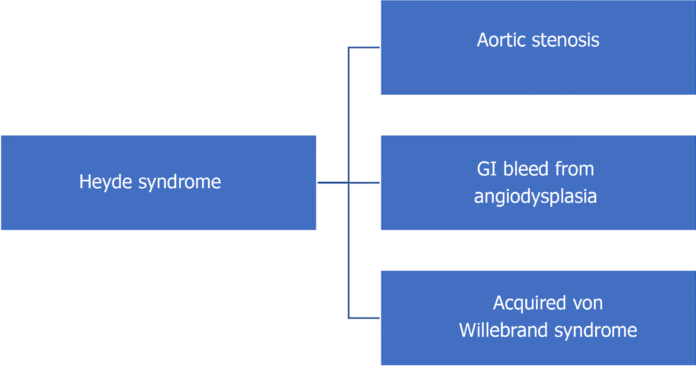Heyde’s Syndrome is a medical condition characterized by the association of aortic stenosis (narrowing of the aortic valve in the heart) and gastrointestinal bleeding due to angiodysplasia (abnormal blood vessels) in the gastrointestinal tract. Here’s an overview of the syndrome:
Overview
Heyde’s Syndrome involves a triad of:
- Aortic Stenosis: A condition where the aortic valve becomes narrowed, restricting blood flow from the heart to the rest of the body.
- Gastrointestinal Angiodysplasia: Dilated and fragile blood vessels in the gastrointestinal tract, which can lead to bleeding.
- Acquired von Willebrand Syndrome: A bleeding disorder caused by the destruction of von Willebrand factor, a protein critical for blood clotting.
Symptoms
The symptoms of Heyde’s Syndrome are typically related to its components:
- Aortic Stenosis:
- Chest pain (angina)
- Shortness of breath
- Fainting (syncope)
- Heart murmur
- Fatigue
- Gastrointestinal Angiodysplasia:
- Gastrointestinal bleeding, which may present as:
- Blood in stool (melena or hematochezia)
- Iron deficiency anemia
- Weakness and fatigue
- Paleness
- Gastrointestinal bleeding, which may present as:
- Acquired von Willebrand Syndrome:
- Excessive bleeding or bruising
- Prolonged bleeding from cuts
- Heavy menstrual periods in women
Causes
The exact cause of Heyde’s Syndrome is not fully understood, but it is believed to involve:
- Mechanical Stress: The turbulence and high shear stress associated with aortic stenosis may damage the von Willebrand factor, leading to an acquired form of von Willebrand disease.
- Aging: Both aortic stenosis and angiodysplasia are more common in elderly individuals, suggesting an age-related degenerative process.
- Genetic Factors: Although not well-defined, there may be a genetic predisposition to the development of angiodysplasia or aortic stenosis.
Treatment
Treatment focuses on addressing both the aortic stenosis and the gastrointestinal bleeding:
- Aortic Valve Replacement: Surgical replacement of the aortic valve can alleviate symptoms of aortic stenosis and often reduces or resolves gastrointestinal bleeding.
- Transcatheter Aortic Valve Replacement (TAVR): A less invasive procedure suitable for high-risk patients.
- Surgical Aortic Valve Replacement (SAVR): Traditional open-heart surgery.
- Management of Gastrointestinal Bleeding:
- Endoscopic Procedures: To locate and treat bleeding sites, including cauterization or clipping of bleeding vessels.
- Medications: Hormonal therapy or antifibrinolytic agents to reduce bleeding.
- Blood Transfusions: For severe anemia.
Prevention
There are no specific measures to prevent Heyde’s Syndrome due to its complex etiology, but general recommendations include:
- Regular Medical Check-ups: Especially for older adults, to monitor heart health and detect aortic stenosis early.
- Managing Cardiovascular Risk Factors: Controlling hypertension, cholesterol, and other risk factors for heart disease.
- Healthy Lifestyle: Including a balanced diet, regular exercise, and avoiding smoking, which can help maintain cardiovascular health.
Conclusion
Heyde’s Syndrome is a complex condition that requires a multidisciplinary approach for diagnosis and management. Treatment primarily involves addressing the underlying aortic stenosis, which often leads to a significant improvement in gastrointestinal symptoms. Regular follow-up and comprehensive care are essential for managing this syndrome effectively.
































